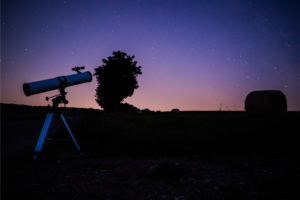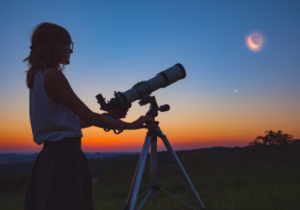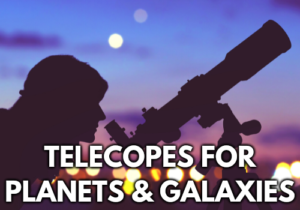7 Best Telescope Eyepieces For All Budgets
Disclosure: This post contains affiliate links and I may earn a small commission (at no extra cost to you) if you click through and make a purchase. Thanks in advance – I really appreciate it!
Most telescopes come with one or two eyepieces which give you one or two magnification options. However, if you want to optimize your viewing experience you’ll need to invest in a better-quality eyepiece.
By having a range of magnifications you can optimize the image, which means you need more eyepieces.
All leading and famous brands of astronomy products manufacturers have their different types of eyepieces.
In this guide, we’re going to help you find some of the best telescope eyepieces and provide you with information that you can use to separate the good from the bad.
Our Pick
Celestron 8-24mm Zoom Eyepiece
- Zoom from low to high power in an instant with this versatile eyepiece
- Compatible with any telescope that accepts 1.25” eyepieces
- This fully multi-coated Premium eyepiece zooms to any focal length between 8 mm and 24 mm - pick the best magnification for your subject
Prices pulled from the Amazon Product Advertising API on:
Product prices and availability are accurate as of the date/time indicated and are subject to change. Any price and availability information displayed on [relevant Amazon Site(s), as applicable] at the time of purchase will apply to the purchase of this product.
For the money, the Celestron 8-24mm Zoom Eyepiece is one of the best telescope eyepieces and one of the most affordable in the market. Characterized for its practicality; you can zoom to any focal length between 8 mm and 24 mm in an instant without changing lenses.
Telescope Eyepieces That We Recommend
| Image | Title | Price | Buy |
|---|---|---|---|
 Top
Top | Celestron 8-24mm Zoom Eyepiece | See on Amazon | |
 Top
Top | Explore Scientific 68° 40mm Eyepiece | See on Amazon | |
 Top
Top | Meade Instruments 100° 10mm Eyepiece | See on Amazon | |
 Top
Top | SVBONY Telescope Eyepiece Set | See on Amazon | |
 Top
Top | Celestron X-Cel LX Series 1.25” 5mm Eyepiece | See on Amazon | |
 Top
Top | Orion E-Series 7-21mm Zoom Eyepiece | See on Amazon | |
 Top
Top | Tele Vue 13mm Ethos 2" / 1.25" Eyepiece | See on Amazon |
Product prices and availability are accurate as of the date/time indicated and are subject to change. Any price and availability information displayed on [relevant Amazon Site(s), as applicable] at the time of purchase will apply to the purchase of this product.
Prices pulled from the Amazon Product Advertising API on:1. Celestron 8-24mm Zoom Eyepiece
- Zoom from low to high power in an instant with this versatile eyepiece
- Compatible with any telescope that accepts 1.25” eyepieces
- This fully multi-coated Premium eyepiece zooms to any focal length between 8 mm and 24 mm - pick the best magnification for your subject
Prices pulled from the Amazon Product Advertising API on:
Product prices and availability are accurate as of the date/time indicated and are subject to change. Any price and availability information displayed on [relevant Amazon Site(s), as applicable] at the time of purchase will apply to the purchase of this product.
The Celestron 8-24 zoom offers an excellent alternative to single focal length eyepieces that would typically cost between $25 and $75 each.
The Celestron 8-24 mm zoom to be a real bargain and a very worthwhile eyepiece. It works smoothly and, it delivers image quality similar to my Plossl eyepieces.
This one eyepiece, when combined with a Barlow lens that is properly matched to your telescope’s focal length, can take the place of four to six eyepieces and allow you to do things that single focal length eyepieces can’t do.
The apparent field of view on this model varies between 40° and 60°, depending on the focal length is selected. The longer the focal length, the wider the field of view.
Eye relief varies between 15mm and 18mm and is perfectly comfortable. There is a deep rubber eyecup attached to the EP, making it easy to achieve a comfortable viewing position. As you’d expect, the cup is retractable for wearers of spectacles.
2. Explore Scientific 68° 40mm Eyepiece
- Focal Length 40mm
- Length114.2 mm Width 80.3mm Weight 35.2oz; 998g
- Barrel Size 2.00
- Eye Relief 31mm
- Field Stop Diameter 45.5mm
Prices pulled from the Amazon Product Advertising API on:
Product prices and availability are accurate as of the date/time indicated and are subject to change. Any price and availability information displayed on [relevant Amazon Site(s), as applicable] at the time of purchase will apply to the purchase of this product.
The 40mm eyepiece with a 68-degree AFOV is a workhorse and performer. It has excellent corrective technologies which is easily recognizable by its aberration-free views.
The view is more than fairly flat, has sharp field stops, little to no light scatter, and has excellent contrast to make out more regardless of where or what you’re looking at.
For those looking for wide fields of view at low power, this is the eyepiece you want to own.
68-degrees provides a great field of view, but when you want more from a given view, it’s contrast and sharpness that you’re after, not necessarily just a super-wide field of view.
The ES 68-degree eyepiece has a baffled interior with a flat, black finish.
The lens elements themselves have blackened edges to help prevent light from scattering and causing internal reflections.
With increased contrast, you can make out more detail on any given object and bring to life some of the faint objects that would otherwise remain unseen.
The eyepiece has an incredibly long 31mm of eye relief. It’s extremely forgiving, so those who wear glasses will be able to comfortably enjoy using this amazing eyepiece.
3. Meade Instruments 100° 10mm Eyepiece
- 10mm Focal Length
- All eyepieces are constructed with premium-grade and exotic optical glass
- Blackened lens edges for superior contrast
Prices pulled from the Amazon Product Advertising API on:
Product prices and availability are accurate as of the date/time indicated and are subject to change. Any price and availability information displayed on [relevant Amazon Site(s), as applicable] at the time of purchase will apply to the purchase of this product.
This eyepiece is a true optical wonder. Featuring a 10 mm focal length, the Meade Instruments 100° 10mm Eyepiece offers up some nice and wide planetary views.
It also has almost 20 mm of eye relief that ensures viewing comfort even for those who wear eyeglasses when they observe.
The eyepiece is constructed with premium-grade and exotic optical glass which delivers great images of the distant sky.
The lenses are Fully Multi-Coated and each element has blackened edges, two extra steps that further increase contrast.
The Meade Instruments 100° 10mm Eyepiece comes with blackened lens edges to further increase image contrast. It also features folding eyecups, in case stargazers want to block stray light from the side.
4. SVBONY Telescope Eyepiece Set
- 1.25 6.3mm 32mm 40mm Plossl eyepiece set give you a good variation in magnification for a wide range of targets with extra sharpness and long eye relief
- 2x Barlow lens doubles the magnification of any 1.25 existing set eyepiece;features T threads to attach a camera to your telescope with optional T ring
Prices pulled from the Amazon Product Advertising API on:
Product prices and availability are accurate as of the date/time indicated and are subject to change. Any price and availability information displayed on [relevant Amazon Site(s), as applicable] at the time of purchase will apply to the purchase of this product.
These Plössl eyepieces offer high magnification and good clarity. They have a four-element design. Furthermore, the edges of each lens are blackened.
This helps to reduce light scattering within the eyepiece. As a result, the image will have more contrast and clarity.
This kit includes a Barlow lens to give you even more high-power magnification capabilities on your telescope.
The kit comes with 3 1.25-inch, 6.3mm, 32mm, 40mm Plossl eyepieces which gives you a good variation in magnification for a wide range of targets with extra sharpness and long eye relief.
5. Celestron X-Cel LX Series 1.25” 5mm Eyepiece
- X-Cel LX eyepieces, optimized for planetary viewing, offer a 60° field of view through a six-element fully multi-coated lens system
- Pop-up rubber eyeguards provide comfort and increase contrast. Raise and lower with a simple twist
- A treaded rubber grip offers a no-slip grip, even with gloves on
- 1.25” barrels are threaded to accept filt
Prices pulled from the Amazon Product Advertising API on:
Product prices and availability are accurate as of the date/time indicated and are subject to change. Any price and availability information displayed on [relevant Amazon Site(s), as applicable] at the time of purchase will apply to the purchase of this product.
Celestron’s X-Cel LX 5mm Eyepiece is designed for comfortable near and deep-space astronomical observation.
It is built with a 6-element lens configuration, blackened edges, and anti-reflective fully multi-coated optical surfaces to ensure bright and clear high-contrast images with true color transmission across the entire wide 60° field of view.
Celestron engineered the X-Cel LX series of eyepieces with a long 16mm eye relief that brings the user’s face back from the scope to minimize vibrations caused by contact with the eyepiece.
With a 1.25″ diameter barrel, it will fit the most common size drawtubes, visual backs, and accessories; and a rubberized collar provides a non-slip grip especially in cold weather and when wearing gloves.
6. Orion E-Series 7-21mm Zoom Eyepiece
- The Orion E-Series Zoom eyepiece allows you to change magnification power without swapping out eyepieces
- A simple twist of the zoom eyepiece housing changes the focal length from 21mm to 7mm, providing a variety of viewing magnification powers
Prices pulled from the Amazon Product Advertising API on:
Product prices and availability are accurate as of the date/time indicated and are subject to change. Any price and availability information displayed on [relevant Amazon Site(s), as applicable] at the time of purchase will apply to the purchase of this product.
The Orion E-Series Zoom Eyepiece makes it possible for even casual telescope users to reap the benefits of zoom eyepiece technology.
It is able to change the telescope focal length from 21mm to 7mm or to any focal length in between, making it perfect for locating an object at low magnification and quickly zooming in to higher magnification for closer observation.
The actual magnification range will depend on the focal length of your telescope.
This Zoom Eyepiece works well for astronomical or terrestrial viewing in smaller refractors or Cassegrain design telescopes.
The E-Series Zoom eyepiece is complete with a 6-element design that gives you the experience of multi-coated optics and comfortably long eye relief ranging from 18mm (at 21mm) to 16.3mm (at 7mm).
The apparent field of view angle ranges from 40 degrees (at 21mm) to 57 degrees (at 7mm).
The 1.25″ barrel is threaded for standard eyepiece filters, making this a quality zoom eyepiece.
7. Tele Vue 13mm Ethos 2″ / 1.25″ Eyepiece
- Apparent Field of View - 100 degrees
- Focal Length - 13mm
- Effective Field Stop - 22.3mm
- Eye Relief - 15mm (accepts DIOPTRX eyesight astigmatism corrector)
- Barrel Size - 2/1
Prices pulled from the Amazon Product Advertising API on:
Product prices and availability are accurate as of the date/time indicated and are subject to change. Any price and availability information displayed on [relevant Amazon Site(s), as applicable] at the time of purchase will apply to the purchase of this product.
Regardless of what you’re looking at, the Tele Vue Ethos is the perfect eyepiece for the job. If you want to see cloud wisps on Jupiter or intricate detail in nebulae and galaxies, you’ll need an eyepiece that can do it.
The Tele Vue is one very large 2” eyepiece with a fantastically wide 100-degree AFOV. It can provide more at any given magnification and even corrects for angular power distortion.
With a 13mm focal length, you can achieve higher power with excellent sharpness and contrast.
Backed by a lifetime warranty, the Ethos is the kind of eyepiece that will never be out of style.
Its superior optics will give you a perfect image edge to edge and possibly the best contrast for those deep-sky objects.
Perfect eye relief is there to help you enjoy the whole ultra-wide view of the skies.
This eyepiece is parfocal with the 10mm Ethos, thus requiring little or no refocusing when changing between the two, and it also accepts astigmatism-correcting DIOPTRX diopters to further improve the view.
What To Look For In A Good Eyepiece
When stargazing, there are lots of factors that affect your experience; the eyepiece is a key one because it defines the magnification power and field of view of that telescope.
However, finding the right eyepiece is no piece of cake. Below, you’ll find a quick guide with the most important factors you have to take into account when buying your next eyepiece.
Focal Length and Magnification
Focal refers to the length of space it takes the lens to diverge light onto a fixed point. To put it simply, it’s a way to represent the overall optical power that a lens has.
The telescope and eyepiece focal length will determine how much magnification power the overall setup has.
Generally, short focal length eyepieces offer more magnifying power.
Of course, magnification isn’t the only thing that matters when it comes to astronomy and astrophotography.
That’s why it’s good to have several eyepieces on hand.
Barrel Size
To make things simpler, barrel size refers to the physical size of the eyepiece barrel (the silver part that inserts into the eyepiece holder).
Today, there are 3 standard sizes of eyepieces in use for amateur telescopes: .965”, 1.25”, and 2″. The 1.25″ is the most common size of the three used in amateur telescopes.
While the 2″ is also common, this size is generally found on larger, more advanced telescopes.
Apparent Field of View
Commonly called out as AFOV in degrees. This is the calculated angular diameter of light you can see through the eyepiece.
Anything less than 40 degrees is considered narrow and is best suited to observing the planets or the moon. 80 degrees and above is considered wide.
A wide field of view provides a more immersive visual experience, especially for large deep-sky objects.
Eye Relief & Exit Pupil
Eye relief is an entirely different considering factor because it’s completely related to ensuring you the utmost comfort.
Indeed, eye relief means the space between your eyes and the eyepiece. You should get 15mm to 20mm of eye relief for a better and relaxed viewing experience.
The exit pupil is the diameter of the beam of light that projects from the eyepiece into the entrance pupil of your eye.
This is important when you observe the faintest deep-sky objects since you need all the gathered light to be projected onto your retina through your widely dilated pupils.
Conclusion
Ranging from budget-friendly to blow-out-your-budget, these top telescope eyepieces and kits offer you a range of options to upgrade whatever eyepiece came with your telescope originally.
Before purchasing an eyepiece, consider the focal length of your telescope, or telescopes, to make sure the eyepiece will provide an appropriate magnification to suit your needs.
If you wear eyeglasses while using a telescope, pay attention to the eye relief specification of different eyepieces, as ample eye relief can improve comfort and ease of use while wearing corrective lenses.
Written by:

Prakash Chandra
I am a science and technology enthusiast who is curious about emerging concepts in spaceflight, aerospace, and robotics. My passion for astronomy started in my childhood, and my craze for writing started when my works got published in my school's newspaper.
ABOUT US
We are a team of active amateur astronomers, here to help you with all your astronomy and science related needs – this is anything, from reviewing the latest telescopes to be released to talking about gravity and neurons. The Big Bang Optics was started because of our love for astronomy and to help others like us find the best telescope and accessories.
LEGAL DISCLAIMER
The Big Bang Optics is a participant in the Amazon Services LLC Associates Program, an affiliate advertising program designed to provide a means for sites to earn advertising fees by advertising and linking to Amazon.com. The Big Bang Optics also participates in affiliate programs with Clickbank and other sites. The Big Bang Optics is compensated for referring traffic and business to these companies.











